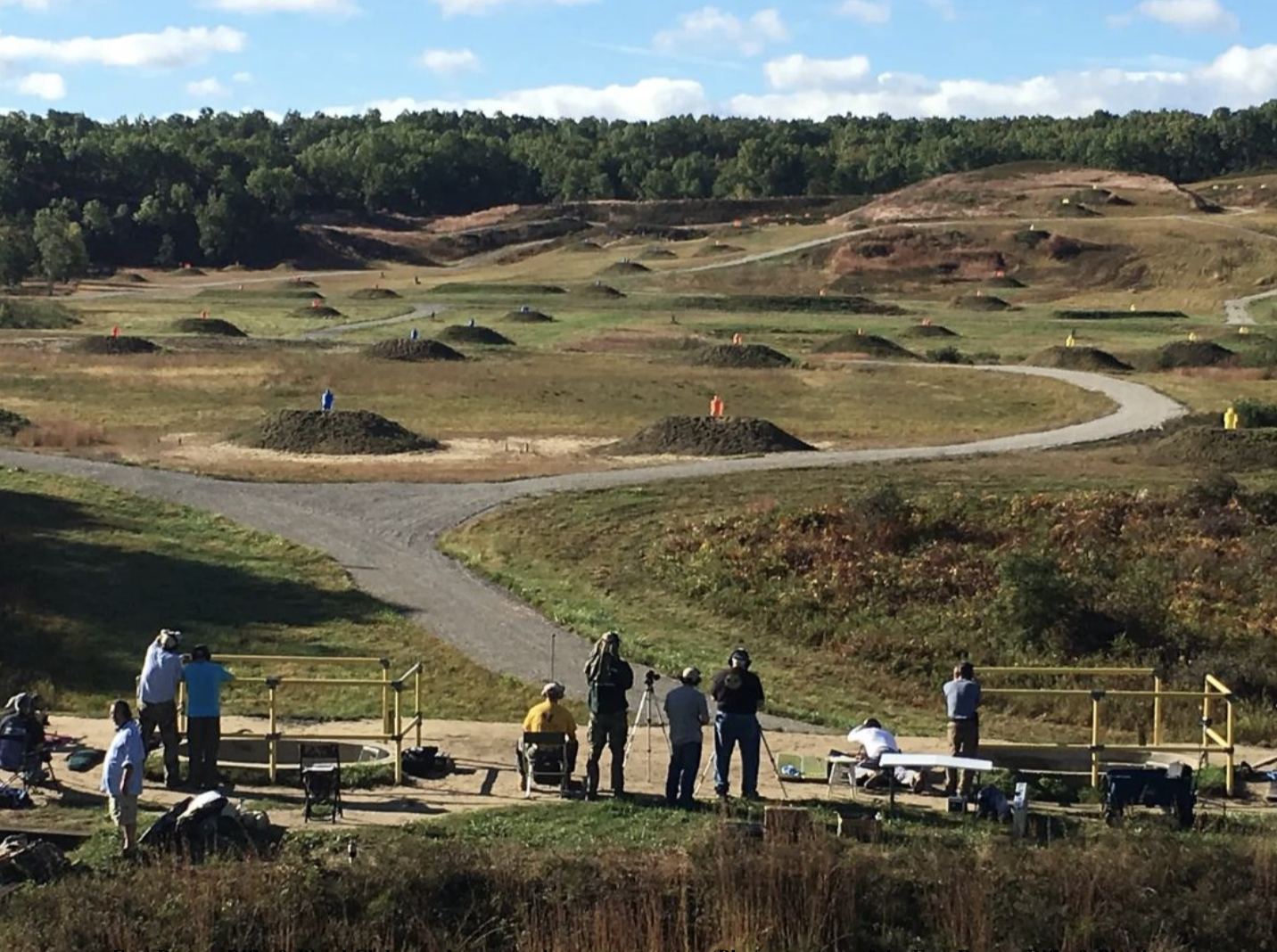By Austin Knudsen
I was recently in one of my favorite Montana gun shops, perusing the used rifle rack and minding my own. It was a Saturday afternoon, and the gun department was fairly busy. As I browsed, I kept noticing one middle-aged gentlemen who was trying to ask questions of the salesmen behind the counter.
One tries not to eavesdrop, but two things quickly became clear: 1) the middle-aged gentlemen knew absolutely nothing about firearms, and 2) the sales staff was losing interest in helping him. That’s not to say that the middle aged man was being obnoxious, nor that the sales staff was being rude.
 The man was well-dressed, and was genuinely trying to elicit information on a subject he knew nothing about. However, the staff was very busy, and while they were trying to be polite, they were just too busy with other customers to give him the education he wanted.
The man was well-dressed, and was genuinely trying to elicit information on a subject he knew nothing about. However, the staff was very busy, and while they were trying to be polite, they were just too busy with other customers to give him the education he wanted.
So, I did something I rarely do: I walked up, introduced myself and asked him if I could answer any questions for him. He politely thanked me, accepted my offer, and introduced himself as “Spencer.”
Spencer was interested in purchasing a home-defense handgun, as he was quite concerned about the state of affairs in the world today. However, Spencer confirmed to me that he knew absolutely nothing about firearms.
He was very polite, clean-cut, well-dressed, and was clearly an educated, successful man. He had brought with him a blank spiral notebook in which he studiously jotted down notes as I walked him through various handgun designs and calibers. When I finally asked him what he thought he wanted to purchase, he sheepishly shrugged, pointed to the GLOCKs, and said, “I guess one of those. That’s what everyone keeps telling me.”
I concurred with him that GLOCKs are a fine product, but then asked him if he knew how a GLOCK –or any semiautomatic handgun- functioned. He shook his head “no,” and assured me that once purchased, he intended to take a firearms class. I concurred again – a class was an excellent idea.
I then gave him a contemplative look and he asked me what I would recommend for him. Without hesitation, I walked him over to the revolver counter and asked the salesman to remove a Smith & Wesson 686 .357 Magnum revolver. Spencer gasped when I said “.357 Magnum.” However, I explained to him that this revolver could also fire the lower power .38 Special cartridge, which is ballistically very similar to the 9mms he had been considering.
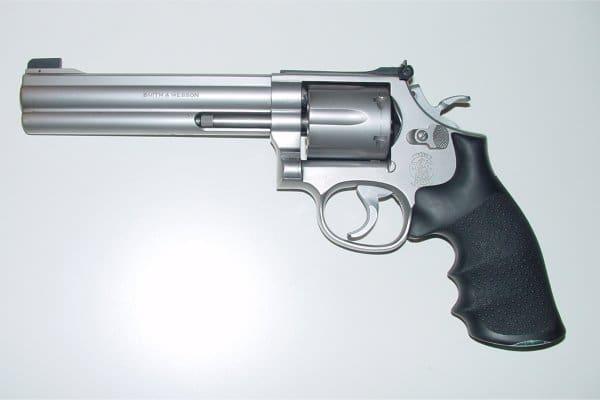
I explained how this revolver is made of solid steel and when fired with .38 Specials, it wouldn’t recoil as much as a semi-auto would (or jam on the occasion of a limp-wrist shot from a new shooter). I then explained to him the simplicity, safety and reliability of a quality double action revolver.
 No, it doesn’t have the ammunition capacity of a semi-auto, but it could be left loaded for years and be picked up at a moment’s notice and fired. In the event of a misfire or dud primer, you just pull the trigger again. To make the revolver completely safe, simply opened up the cylinder.
No, it doesn’t have the ammunition capacity of a semi-auto, but it could be left loaded for years and be picked up at a moment’s notice and fired. In the event of a misfire or dud primer, you just pull the trigger again. To make the revolver completely safe, simply opened up the cylinder.
We shook hands and Spencer left the store that day without purchasing anything, but I had obviously given him more to think about and he went home to research revolvers.
If you spend any time on internet firearm forums, there are inevitably a dozen, “if you could have only one gun…” threads or discussions going on. While I find these “only one gun” discussions, A) horrifying, because why would I possibly only have one gun, and B) pointless because we don’t live in a country with such restrictions (at least not yet), they do set a guy to thinking.
If, God forbid, I was limited to only one firearm, what would it be? A .30-06 bolt action rifle? A pump action 12 gauge shotgun? A good .22 rifle? I could make the case for all of those for a one-gun battery. But after a couple of days sitting in the tractor pondering the question, I always come back to the same conclusion: if I could own only one gun, it would be a Smith & Wesson model 686 .357 magnum revolver with a 4 inch barrel.
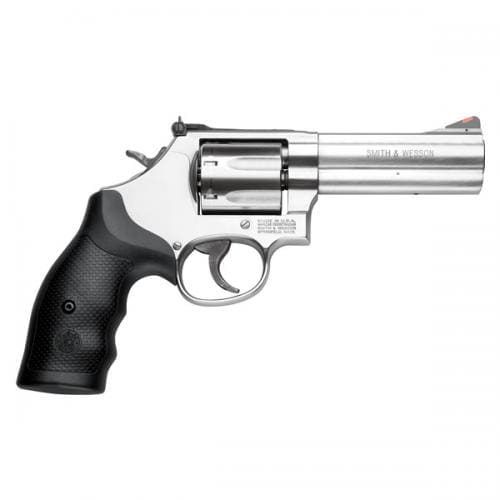
Introduced in 1980, Smith & Wesson’s 686 “L frame” was designed specifically for the .357 Magnum cartridge. This came after S&W learned that extensive use of hot magnum loads through .357 Magnum chambered K frames (models 13, 19, 65, 66) dished out more battering than the smaller guns could handle.
 Beefier than the K frame but not as massive as the N frame, the L frame models 686 (stainless steel, adjustable sights), 681 (stainless steel, fixed sights), 586 (blued finish, adjustable sights) and 581 (blued finish, fixed sights) could take the steady pounding of heavy .357 magnums and keep on ticking.
Beefier than the K frame but not as massive as the N frame, the L frame models 686 (stainless steel, adjustable sights), 681 (stainless steel, fixed sights), 586 (blued finish, adjustable sights) and 581 (blued finish, fixed sights) could take the steady pounding of heavy .357 magnums and keep on ticking.
Also, for the first time in its production history, S&W installed full underlugged barrels on the L frames. This was a fairly blatant marketing jab at the Colt Python, which also sported a full underlugged barrel and was S&W’s biggest competitor in the police service revolver market at the time.
Full disclosure: the 686 was my first big handgun (as in, not a .22). On my 18th birthday, my dad presented me with a new-in-the-box 686 that had been sitting in the local hardware store’s display case for over 15 years. It was a 686 “no dash,” indicating it was an early model with the hammer-mounted firing pin, which predated any engineering changes.
It also had never been back to the S&W factory for the “M” stamp modification, which is a replacement firing pin bushing in the frame to prevent primer flow with high pressure loads. My 686 sported a 8 3/8″ inch barrel with a partridge front sight, square butt frame, wide serrated target trigger, and original S&W target wood grips, aka “cokes.” This picture is a pretty close representation:

I carried and shot my 686 in this form for a couple of years on the ranch, shooting pests and targets with bulk .38 special rounds until I was, without bragging, a pretty decent long-range shot with it.
 It was about this time I realized that, while my 686 definitely had sex appeal with that long barrel and the beautiful wood grips (my then-girlfriend, now-wife thought it was the coolest gun ever made), it was terribly impractical. The huge coke bottle target grips, while pretty, had never fit my short-fingered hands. On top of that, I had put a good scratch in one of the grips while crawling over a barbed wire fence, and that clinched it: the pretty wood grips had to be replaced with something tougher that fit my hand better.
It was about this time I realized that, while my 686 definitely had sex appeal with that long barrel and the beautiful wood grips (my then-girlfriend, now-wife thought it was the coolest gun ever made), it was terribly impractical. The huge coke bottle target grips, while pretty, had never fit my short-fingered hands. On top of that, I had put a good scratch in one of the grips while crawling over a barbed wire fence, and that clinched it: the pretty wood grips had to be replaced with something tougher that fit my hand better.
A Hogue rubber grip was purchased and installed, and voila, the new grips fit my hand. My 686 stayed in this form for a few more years, until one year while packing into mountain sheep – and grizzly bear – backcountry on horseback for a week of scouting, I had the bright idea to carry the 686 in an old Jackass shoulder holster rig I had found in a pawnshop.
While the rig definitely looked cool in the bathroom mirror with my long-barreled 686 strapped into it a la Dirty Harry, a week on horseback and climbing mountains spotting for sheep taught me that packing a 8 3/8” barreled howitzer in a shoulder holster was a miserable experience and not for me (that was the first and last shoulder holster I’ve ever purchased). I realized I needed a shorter barreled revolver.
I didn’t have the money to simply go out and purchase another 686. At this time of my life, any decent S&W revolver was selling for $400 and up (ah, the good ol’ days), I had just gotten married, and my gun fund was non-existent.
The only way I was getting another revolver was by selling or trading the one I had. And I really didn’t want to part with my 686, even for another 686. It was my first “big gun,” and was a gift from my father. I was a crack shot with it, and had more than once made outstanding long-range shots that were witnessed by others. So the 686 stayed as it was. And then I started reading Elmer Keith.
In one of his books, Elmer talked about having one of his Smith & Wesson Model 29 .44 Magnum revolvers re-barreled to the more-handy 4-inch length. His work was done at the Smith & Wesson factory, but this got me to thinking: why couldn’t I re-barrel my revolver myself?
I bought a used 4-inch 686 barrel from an internet vendor and, upon its delivery, set to reading about how to undertake the task. A little trial and error, some hand filing and emery cloth, and several hours later, my work paid off: my old 686 had been transformed into a much handier 4” barrel revolver.
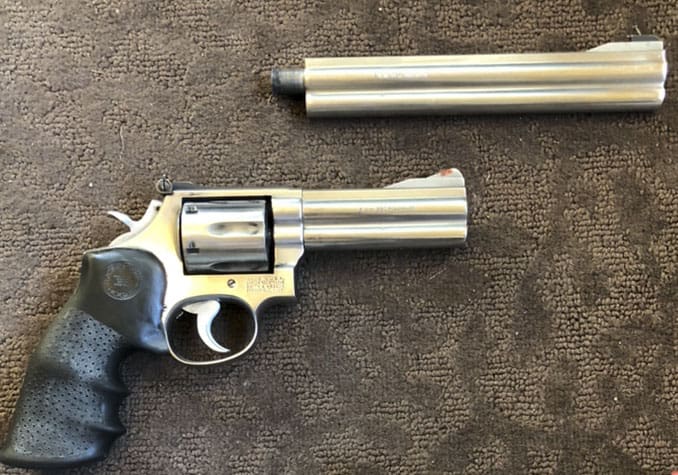
Needless to say, the old girl balanced and carried much better than it did with the 8 3/8” tube. The shoulder holster was tossed in the leather drawer, replaced by a Bianchi strong side pancake holster, and I actually carried the gun as my primary CCW gun for a couple years.
 As my gun fund grew and other handguns were purchased, the 686 was carried less and less, especially when I started getting into USPSA and later 3-Gun competition. And then, a few years ago, a funny thing happened: my wife and I attended a Friends of the NRA banquet in Helena, Montana. On a lark, I purchased a raffle ticket. Sure enough, my name was called and I suddenly became the owner of a brand new, 4-inch model 686.
As my gun fund grew and other handguns were purchased, the 686 was carried less and less, especially when I started getting into USPSA and later 3-Gun competition. And then, a few years ago, a funny thing happened: my wife and I attended a Friends of the NRA banquet in Helena, Montana. On a lark, I purchased a raffle ticket. Sure enough, my name was called and I suddenly became the owner of a brand new, 4-inch model 686.
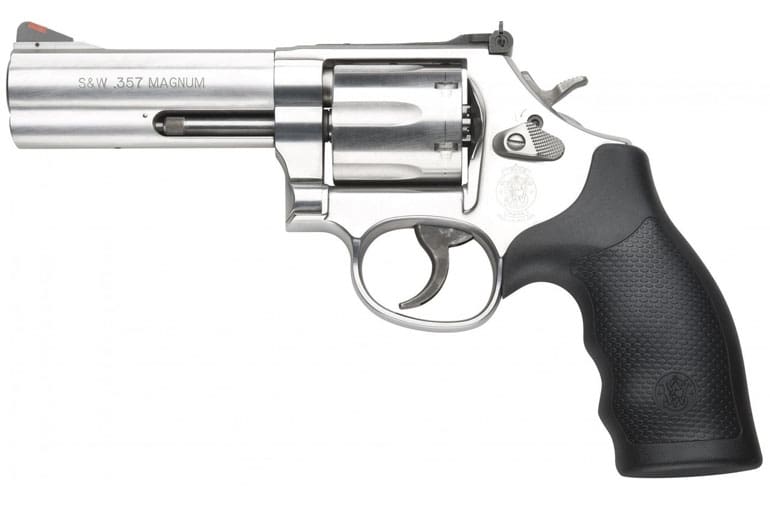
This was a new-manufactured model, and was actually a 686-6 (indicating it was S&W’s sixth engineering change to the model). It differed from my old 686 in that the new one had a round butt grip frame, a frame-mounted firing pin, a redesigned extractor star, MIM parts, and, unfortunately, the dreaded Clinton lock.
 Home with me and into the safe, next to the old 686 it went. Both went largely unfired for a couple of years.
Home with me and into the safe, next to the old 686 it went. Both went largely unfired for a couple of years.
The Question
I’ve recently been nostalgic about my neglected revolvers, and I got to wondering: would the new 686 shoot as good as the old 686? And then an even more interesting question: how would the old 686 stack up if I re-installed that original 8 3/8 inch barrel?
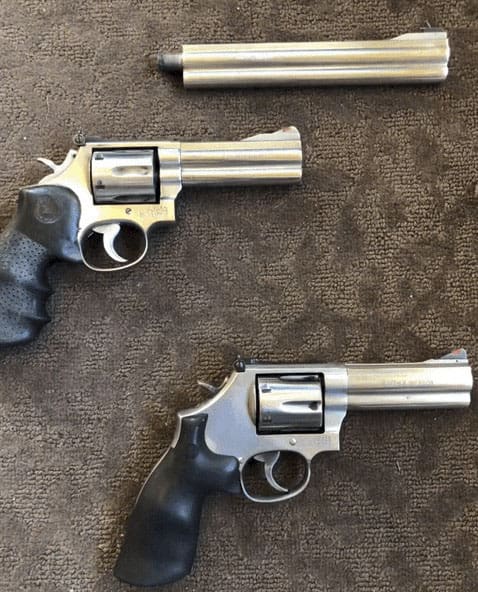
 My testing protocol: the old 4” and the new 4” 686s were fired by me, single-action, from a seated position off of a rest, at a paper target at 25 yards. Five different loads were used to fire five six-shot groups: three .357 Magnum hand loads, one .38 Special hand load and one .38 Special factory load. Then, I uninstalled the 4” barrel from my old 686 and reinstalled the original 8 3/8” barrel. Once done, I repeated the test firings with the same 5 loads through the now-long barreled 686. In effect, I tested 3 different S&W 686s, to see if date of manufacture and/or barrel length had any effect on accuracy.
My testing protocol: the old 4” and the new 4” 686s were fired by me, single-action, from a seated position off of a rest, at a paper target at 25 yards. Five different loads were used to fire five six-shot groups: three .357 Magnum hand loads, one .38 Special hand load and one .38 Special factory load. Then, I uninstalled the 4” barrel from my old 686 and reinstalled the original 8 3/8” barrel. Once done, I repeated the test firings with the same 5 loads through the now-long barreled 686. In effect, I tested 3 different S&W 686s, to see if date of manufacture and/or barrel length had any effect on accuracy.
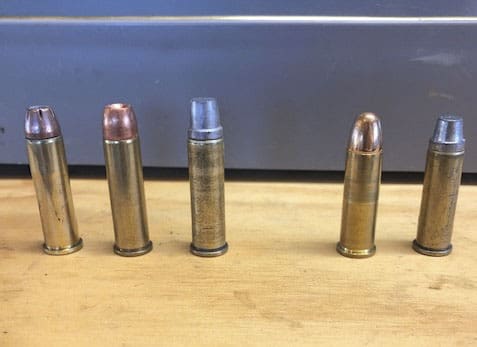
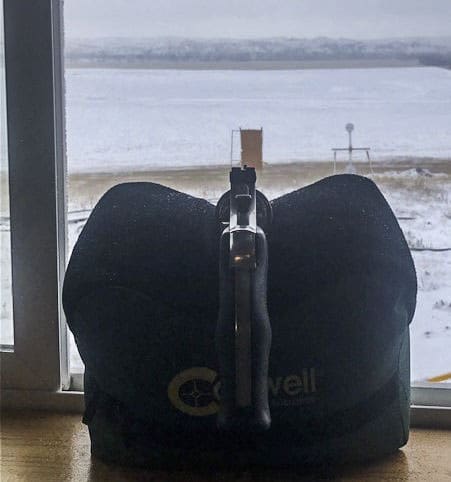
This test did not go the way I thought it would. Everybody knows that old Smith & Wesson revolvers shoot better than new Smith & Wesson revolvers, right? Wrong.

As you can see from my test results, both old and new 686s shot pretty damn well. Neither revolver particularly cared for my 158 grain lead semi-wadcutter .38 Special reloads.
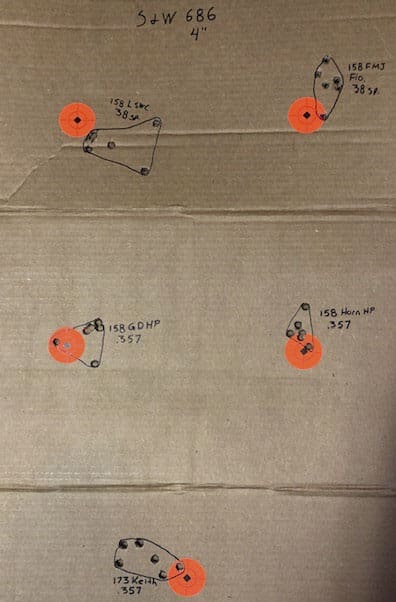
 However, they both shot everything else pretty well, and both guns had definite favorites. The old 686 4” really liked my .357 Magnum reload consisting of a Hornady 158 grain hollow point and 13 grains of Alliant 2400.
However, they both shot everything else pretty well, and both guns had definite favorites. The old 686 4” really liked my .357 Magnum reload consisting of a Hornady 158 grain hollow point and 13 grains of Alliant 2400.
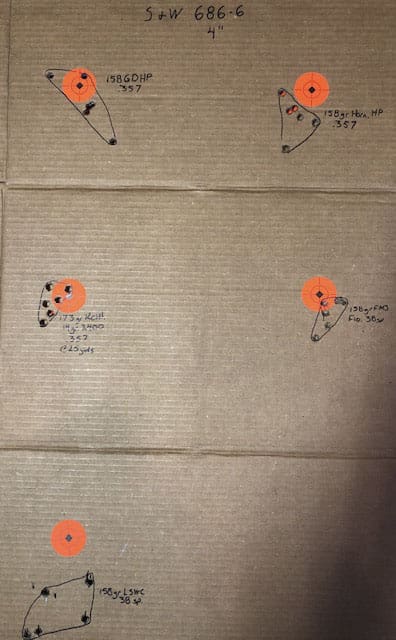
On the other hand, the new 686 positively made my heart sing when it put up an excellent group using my .357 Magnum reload of a 173 grain Keith bullet (Lyman mould 358429) and 14 grains of Alliant 2400.
First a disclaimer: re-barreling a Smith & Wesson revolver is not for the novice gunsmith, nor the faint of heart. If you are impatient, or don’t know how to operate tools, or don’t have the correct tools, or aren’t incredibly anal retentive, DON’T TRY IT. Hire a gunsmith. That’s what they get paid for. Seriously, if you mess up, you can destroy a perfectly good revolver.
With that said, it’s possible to re-barrel your own S&W revolver at home, if you have some mechanical inclination and are patient and meticulous. I won’t take the time to go through the process here, as it would probably have enough content for its own article. Maybe some other time.
The point is, I took my time, properly uninstalled the 4-inch barrel from my old 686 and replaced it with the original 8 3/8 inch barrel. When I got done, this is what I had:

The Hogue grip was reinstalled, and then back to the shooting bench I went.

With the 8 3/8-inch tube reinstalled, I was tickled when my old girl put up four pretty fair groups. Notice that the point of impact for all groups was higher than with the 4” barreled guns.
 The long 686 didn’t like my 158 grain LSWC .38 Special hand load any better than the other two guns had; however everything else shot pretty well. The lone factory offering, the Fiocchi 158 grain FMJ .38 Special, posted a very good 1 ½” group, with two shots in the same hole:
The long 686 didn’t like my 158 grain LSWC .38 Special hand load any better than the other two guns had; however everything else shot pretty well. The lone factory offering, the Fiocchi 158 grain FMJ .38 Special, posted a very good 1 ½” group, with two shots in the same hole:

Once again, my 173 grain Keith .357 Magnum load performed excellently, putting up a six shot group just north of 1 ½”.

Another impressive group came from the 158 grain Speer Gold Dot .357 Magnum hand load, which was posting a sub-one inch group until a slight flyer opened the group to 1 ½”:

But the real winner was the Hornady 158 grain jacketed hollow point .357 Magnum hand load, which posted this legit 1” group:

So what did I learn? From 30,000 feet, Smith & Wesson made a damn fine revolver in 1980, and they still make a damn fine revolver now. The older, long barreled 686 shot the best groups, but I suspect that has more to do with 1) its longer sight radius, and 2) its excellent partridge-style target front sight.
Both of these assets let me shoot the long 686 more accurately. I honestly can’t say that either the new or old 4-inch 686s aren’t capable of the same accuracy. In fact both shot excellently. They’re simply shorter-barreled and sport red-ramped combat front sights, which I don’t find as precise for target shooting.
In short, the Smith & Wesson 686 is one of the most versatile, utilitarian firearms ever made. This revolver can do just about anything: personal protection with proper 125 or 158 grain JHPs; mountain/woods duty loaded with heavy Buffalo Bore factory ammo or hand loads consisting of 173 grain cast Keith bullets in front of a good dose of 2400; or plinking/target shooting with (relatively) inexpensive .38 special fodder. Heck, I’ll even load my first couple chambers with CCI shot shells and carry it to dispatch the inevitable summer rattlesnakes on our place.
Over the years, several friends and acquaintances who learned I’m a “gun guy” asked me for advice when they want to buy themselves a handgun. To a person, they want to buy the blackest, coolest-looking semi-auto in the gun shop case.
My advice for new handgun shooters is always the same: start with a .22, and shoot it. Then shoot it some more, and then shoot it some more. Then, buy a quality .357 revolver, like the S&W 686.
The 686 is simple to operate, simple to load, easy to shoot, and most importantly for a new shooter, safe. There are no external safeties to fuss with, just a long, smooth double action trigger pull, or an excellent crisp single action trigger pull.
Flop the cylinder open, and the firearm is completely safe for everyone to see. Even for the seasoned shooter, the craftsmanship and accuracy offered by the S&W 686 can be refreshing.
All images courtesy the author.





